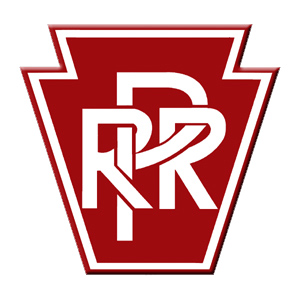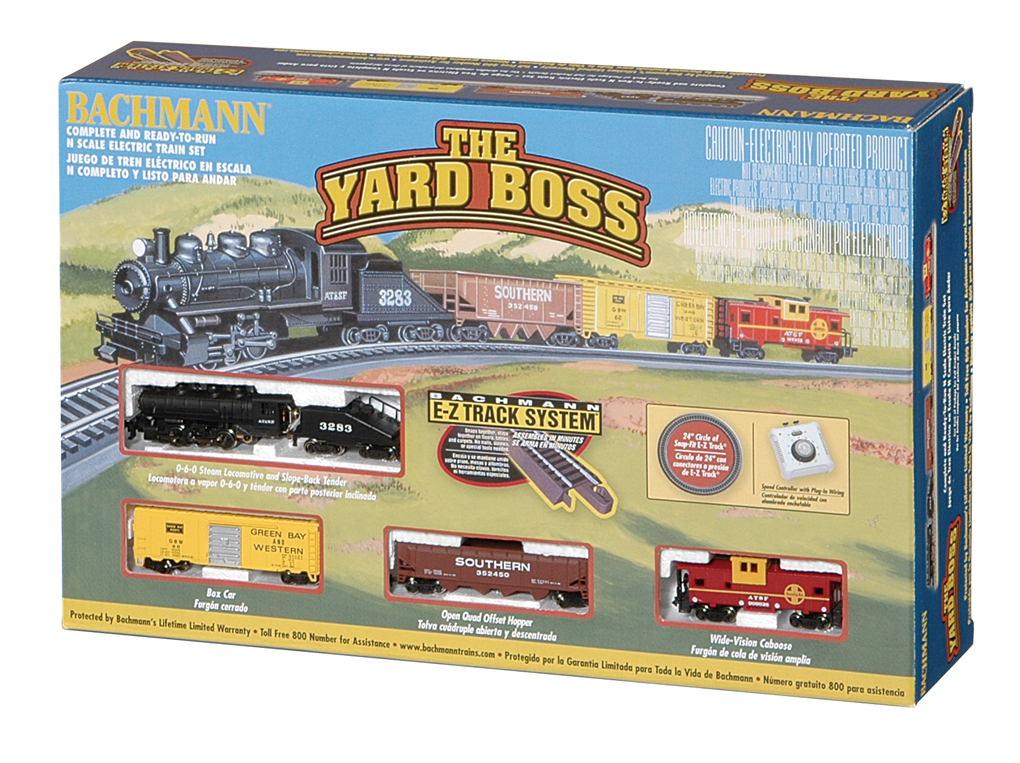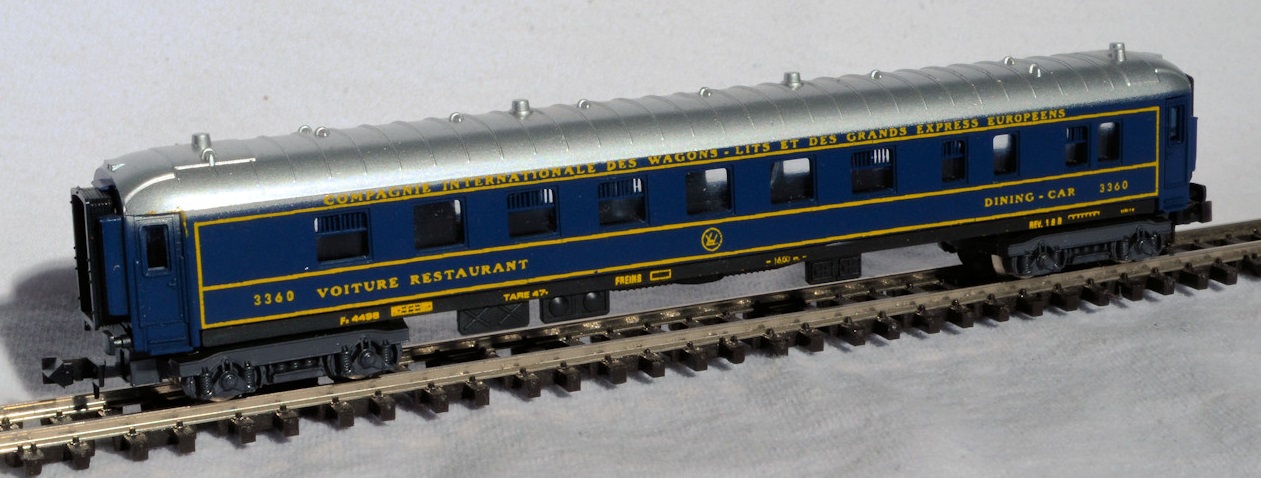Lima - 354 - Passenger Car, British Rail, Mark 1 Coach - Pennsylvania - 1410
| Stock Number | 354 |
| Brand | Lima |
| Manufacturer | Lima |
| Body Style | Lima Passenger BR Mk1 CK |
| Prototype Vehicle | Passenger Car, British Rail, Mark 1 Coach (Details) |
| Road or Company Name | Pennsylvania (Details) |
| Road or Reporting Number | 1410 |
| Paint Color(s) | Tuscan Red w. Silver roof |
| Print Color(s) | Black and Yellow |
| Additional Markings/Slogan | Dining Car |
| Coupler Type | Rapido Hook |
| Coupler Mount | Truck-Mount |
| Wheel Type | Nickel-Silver Plated Metal |
| Wheel Profile | Deep Flange |
| Release Date | 1968-01-01 |
| Item Category | Passenger Cars |
| Model Type | British |
| Model Subtype | Mark 1 coach |
| Model Variety | Composite Corridor (CK) |
| Prototype Region | Europe |
| Prototype Era | UK Era 4: BR Early crest (1948-1956) |
| Years Produced | 1951-1963 |
| Scale | 1/160 |
Specific Item Information:
Introduced in the 1968 catalog - disappeared a couple of years after.
Non prototypical, based on a British coach car.
Non prototypical, based on a British coach car.
Model Information:
This Mk1 Composite Corridor (CK) coach was introduced in 1967 by Lima in blue/gray BR livery. It was later released in several other liveries, up until the mid-1980's when Lima stopped offering N gauge models for the UK market.
Three other types of Mk1 coaches were introduced as well: BSK (Brake Standard Corridor), RMB (Restaurant Miniature Buffet) and BG (Brake Gangwayed, baggage).
They were distributed in the UK by Wrenn Micromodel, but also available under the Lima brand; so they can be found in either on or the other packaging.
These coaches are reputed as being under-sized in a visible manner; therefore we consider them as of 1:160 scale, and not as of 1:148 British N gauge.
Three other types of Mk1 coaches were introduced as well: BSK (Brake Standard Corridor), RMB (Restaurant Miniature Buffet) and BG (Brake Gangwayed, baggage).
They were distributed in the UK by Wrenn Micromodel, but also available under the Lima brand; so they can be found in either on or the other packaging.
These coaches are reputed as being under-sized in a visible manner; therefore we consider them as of 1:160 scale, and not as of 1:148 British N gauge.
Prototype History:
British Railways Mark 1 was the family designation for the first standardised designs of railway carriages built by British Railways. Following nationalisation in 1948, BR had continued to build carriages to the designs of the "Big Four" companies (the Great Western, Southern, London Midland and Scottish and London and North Eastern railways), and the Mark 1 was intended to be the standard carriage design for use across all lines, incorporating the best features of each of the former companies' designs. It was also designed to be much stronger than previous designs, to provide better protection for passengers in the event of a collision or derailment.
The Mk 1 coaches were built in two distinct tranches: the early vehicles (1951–60) and the 'Commonwealth' stock (named from the type of bogie used) from 1961 onwards.
They have been painted in a large variety of liveries and very produced in various types: First, Second or Composite, Coach, Brake/Coach, Restaurant, etc.
The Mk 1 coaches have been in operation until 2005.
From Wikipedia
The Mk 1 coaches were built in two distinct tranches: the early vehicles (1951–60) and the 'Commonwealth' stock (named from the type of bogie used) from 1961 onwards.
They have been painted in a large variety of liveries and very produced in various types: First, Second or Composite, Coach, Brake/Coach, Restaurant, etc.
The Mk 1 coaches have been in operation until 2005.
From Wikipedia
Road Name History:
The Pennsylvania Railroad (reporting mark PRR) was an American Class I railroad, founded in 1846. Commonly referred to as the "Pennsy," the PRR was headquartered in Philadelphia, Pennsylvania.
The PRR was the largest railroad by traffic and revenue in the U.S. for the first half of the twentieth century. Over the years, it acquired, merged with or owned part of at least 800 other rail lines and companies. At the end of 1925, it operated 10,515 miles of rail line; in the 1920s, it carried nearly three times the traffic as other railroads of comparable length, such as the Union Pacific or Atchison, Topeka & Santa Fe railroads. Its only formidable rival was the New York Central (NYC), which carried around three-quarters of PRR's ton-miles.
At one time, the PRR was the largest publicly traded corporation in the world, with a budget larger than that of the U.S. government and a workforce of about 250,000 people. The corporation still holds the record for the longest continuous dividend history: it paid out annual dividends to shareholders for more than 100 years in a row.
In 1968, PRR merged with rival NYC to form the Penn Central Transportation Company, which filed for bankruptcy within two years. The viable parts were transferred in 1976 to Conrail, which was itself broken up in 1999, with 58 percent of the system going to the Norfolk Southern Railway (NS), including nearly all of the former PRR. Amtrak received the electrified segment east of Harrisburg.
The PRR was the largest railroad by traffic and revenue in the U.S. for the first half of the twentieth century. Over the years, it acquired, merged with or owned part of at least 800 other rail lines and companies. At the end of 1925, it operated 10,515 miles of rail line; in the 1920s, it carried nearly three times the traffic as other railroads of comparable length, such as the Union Pacific or Atchison, Topeka & Santa Fe railroads. Its only formidable rival was the New York Central (NYC), which carried around three-quarters of PRR's ton-miles.
At one time, the PRR was the largest publicly traded corporation in the world, with a budget larger than that of the U.S. government and a workforce of about 250,000 people. The corporation still holds the record for the longest continuous dividend history: it paid out annual dividends to shareholders for more than 100 years in a row.
In 1968, PRR merged with rival NYC to form the Penn Central Transportation Company, which filed for bankruptcy within two years. The viable parts were transferred in 1976 to Conrail, which was itself broken up in 1999, with 58 percent of the system going to the Norfolk Southern Railway (NS), including nearly all of the former PRR. Amtrak received the electrified segment east of Harrisburg.
Brand/Importer Information:
Lima N scale European models were numbered with 3 digits until 1978. They were renumbered after 1978 by adding "320" before the previous number. e.g. "306" became "320306".
Manufacturer Information:
 Lima S.p.A (Lima Models) was a brand of railway models made in Vicenza, Italy, for almost 50 years, from the early 1950s until the company ceased trading in 2004. Lima was a popular, affordable brand of 00 gauge and N gauge model railway material in the UK, more detailed H0 and N gauge models in France, Germany, Italy, Switzerland, and the United States as well as South Africa, Scandinavia and Australia. Lima also produced a small range of 0 gauge models. Lima partnered with various distributors and manufacturers, selling under brands such as A.H.M., Model Power, Minitrain and PMI (Precision Models of Italy). Market pressures from superior Far Eastern produce in the mid-1990s led to Lima merging with Rivarossi, Arnold, and Jouef. Ultimately, these consolidations failed and operations ceased in 2004.
Lima S.p.A (Lima Models) was a brand of railway models made in Vicenza, Italy, for almost 50 years, from the early 1950s until the company ceased trading in 2004. Lima was a popular, affordable brand of 00 gauge and N gauge model railway material in the UK, more detailed H0 and N gauge models in France, Germany, Italy, Switzerland, and the United States as well as South Africa, Scandinavia and Australia. Lima also produced a small range of 0 gauge models. Lima partnered with various distributors and manufacturers, selling under brands such as A.H.M., Model Power, Minitrain and PMI (Precision Models of Italy). Market pressures from superior Far Eastern produce in the mid-1990s led to Lima merging with Rivarossi, Arnold, and Jouef. Ultimately, these consolidations failed and operations ceased in 2004.
Hornby Railways offered €8 million to acquire Lima's assets (including tooling, inventory, and the various brand names) in March of the same year, the Italian bankruptcy court of Brescia (town near Milan, last headquarters of Lima) approving the offer later that year. In December 2004, Hornby Railways formally announced the acquisition along with the Rivarossi (H0 North American and Italian prototypes), Arnold (N scale European prototypes), Jouef (H0 scale French prototypes), and Pocher (die-cast metal automobile kits) ranges. As of mid-2006, a range of these products has been made available under the Hornby International brand, refitted with NEM couplings and sprung buffers and sockets for DCC (Digital Command Control) decoders.
From Wikipedia

Hornby Railways offered €8 million to acquire Lima's assets (including tooling, inventory, and the various brand names) in March of the same year, the Italian bankruptcy court of Brescia (town near Milan, last headquarters of Lima) approving the offer later that year. In December 2004, Hornby Railways formally announced the acquisition along with the Rivarossi (H0 North American and Italian prototypes), Arnold (N scale European prototypes), Jouef (H0 scale French prototypes), and Pocher (die-cast metal automobile kits) ranges. As of mid-2006, a range of these products has been made available under the Hornby International brand, refitted with NEM couplings and sprung buffers and sockets for DCC (Digital Command Control) decoders.
From Wikipedia
Item created by: Alain LM
on 2020-02-10 13:52:51
Last edited by: Alain LM on 2020-11-01 09:56:26
If you see errors or missing data in this entry, please feel free to log in and edit it. Anyone with a Gmail account can log in instantly.
Last edited by: Alain LM on 2020-11-01 09:56:26
If you see errors or missing data in this entry, please feel free to log in and edit it. Anyone with a Gmail account can log in instantly.










